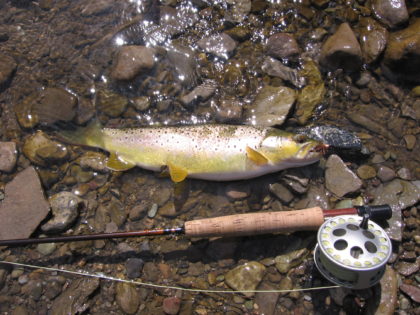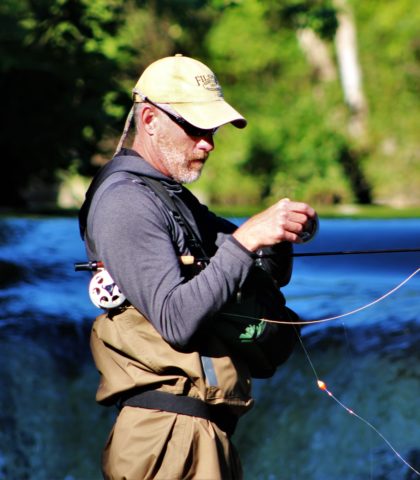
As a boy, with my spinning rod and reel bundled and tied to the frame of my BMX bike with rubber bands and bread ties, I spent many summer days pedaling from my home in the hilly suburbia of Syracuse to the nearby Erie Canal towpath. Once reached, I could travel the towpath west to Butternut Creek or east to Limestone Creek.
Each creek, with its remote green pools of cold water, was an oasis of summer adventure where I fished and explored. In those days the creeks were healthy. Shaded by dense softwood canopies and rich with beds of clean gravel. Colorful trout were plentiful and big.
Many, many hours of my youth were spent on these two creeks. Fishing, swimming, wading, turning over rocks, catching crayfish, hellgrammites, water snakes, turtles, as well as trout. Most days my only companion was the family dog. An Irish Setter named Clancy.
Dunking worms and pitching spinners defined the limits of my early trout fishing technique. It worked well and spin casting was a simple and easy way to catch trout. Grasping a trout, feeling their cold, slick skin, admiring their bright spots and golden sides, then watching as they bolted away after being released back in to the creek…I found it fascinating.
One hot August afternoon my trout fishing changed. Setting at the base of a giant limestone aquaduct, I noticed a trout in the middle of the creek several yards upstream. A trout larger than any I had seen before. A flip of the Mepps spinner and the big trout slid away to the opposite bank and sank into submerged roots. After several casts with no results I set the rod down and watched. Soon the trout made its way back to its lie in the center of the creek.
The water was crystal clear, the sun was hot and a loud chorus of cicadas grinded away in the tops of the huge willow trees that lined the red clay banks. Cedar waxwings and swallows flew through the giant arches of the limestone aquaduct snapping up bugs.
The trouts’ head and tail were enormous and his spots the size of a penny. I just sat and watched. And every few minutes, in the calm fashion of an old and confident trout, the big brown would swim forward and upward and take a flying ant from the surface of the creek.

That evening, after dinner, I went into my fathers workshop in the basement and helped myself to his fishing tackle. Inside the pockets of his fishing vest was a chalky aluminum box that held a couple dozen gaudy chenille-body flies, the kind the local hardware store sold in two-packs next to the metal stringers and plastic worm cans. Inside that box was a few flying ant patterns complete with clipped mallard-flank wings!
Resting on two nails in the floor joists above my head was a white fiberglass Shakespeare fly rod. Attached to the chipped and gray cork handle was a Phleuger reel that was wound with an old and cracked fly line and short leader.
The next day I lashed the rod to my bike and with Clancy in-tow I headed to the creek. The flying ant was tied on to the end of the leader as I sat on the bank and waited for the trout to appear. But he never did. After a few casts and after breaking off most of my flies in the tree branches, Clancy and I climbed the steep bank, traversed the narrow stone ledge on the top of the aquaduct and headed home.
While flying down the towpath on my bike I spied the usual schools of bluegills in the shaded canal water beneath big maple trees. I skidded to a halt, rigged the rod, and began to cast the flying ant. As soon as the fly touched the water the bluegill exploded on it! I walked up and down the towpath catching bluegill after bluegill after bluegill with this new wand, this new thing. This Wonderod.
That hot summer day some thirty five years ago, setting on the creek bank with my dog watching that brown trout, is a cherished memory of mine. It takes me back to the days of my youth when worries did not exist and time stood as still and fine as it ever will be.
My bike, my fishing rod and my dog were all I needed and wanted. It was in those moments that I became fascinated with trout and the places they live. In fly fishing I found a complex connection to the trout and its environment that would endure and grow. Fly fishing became something I will enjoy for the rest of my life.


